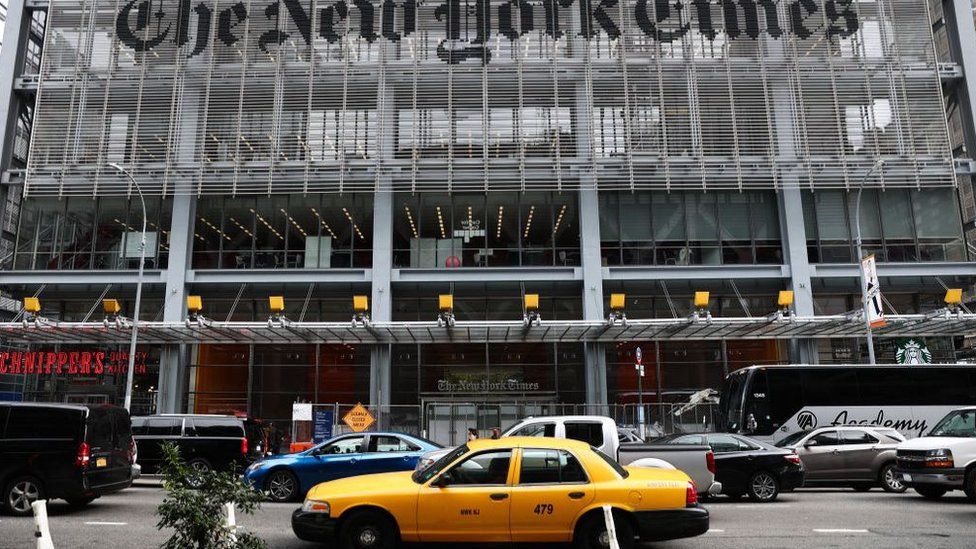ARTICLE AD BOX

The New York Times is facing its first major work stoppage since the 1970s, after staff demanding better pay and benefits declared a 24-hour walkout.
The firm said it was disappointed by the decision but was prepared to serve readers "without disruption".
The stand-off comes at a time of heightened labour unrest in the US, as the cost of living continues to rise.
Union members say the company can afford their demands, despite challenges in the wider news business.
"We're incredibly fortunate to work for one of the few places in media, or print media, that is profitable, healthily profitable," said sports reporter Kevin Draper. "And yet the proposals that management have made are barely better than what we got last time."
More than 1,100 union members are planning to participate in the 8 December walkout, including big names such as film critic AO Scott.
At the end of 2021, the New York Times employed about 5,000 people, including more than 2,000 in journalism operations.
The union said it would leave some departments with nearly no one at work - though some units will be less affected.
International staff, for example, are not part of the union, which means the World Cup coverage that has been dominating sports news is unaffected, Mr Draper said.
Image source, Getty Images
Image caption,Major newspaper strikes in New York City in the 1960s upended the industry
The last contract was negotiated in 2017, when the New York Times was still finding its way through the disruption triggered by the rise of tech giants such as Google, which have drawn advertising dollars away from traditional news.
Since then the company has successfully shifted away from advertising to rely primarily on paid subscriptions. In a recent update to investors, it said that revenue was expected to rise further, forecasting a strong year.
Union members, who are represented by the NewsGuild of New York, said the the firm's performance - and its ability to spend millions on executive compensation, share buybacks and dividends - had informed their demands.
Since the prior contract expired in March 2021, the two sides have been at odds over issues such as starting pay, wage increases, retirement and health care policies and remote work.
In recent negotiations including a 12-hour session on Tuesday, the company agreed to higher pay increases than it had offered previously - including 3% guaranteed raises in 2023 and 2024 - and dropped a proposal to scrap pensions, among other changes.
"Our proposals today show our good-faith effort to get things going at the bargaining table," Cliff Levy, a deputy managing editor, wrote in an email to staff on Tuesday. "We are eager for the NewsGuild to join us in seeking common ground and making significant progress."
The proposal did not satisfy the union, which represents roughly 1,400 people, including comment moderators, security guards and reporters.
It said it was pushing to secure a $65,000 (£53,000) starting salary and pay raises of 5.5% in 2023 and 2024, noting that the company's proposals have not made up for the rising cost of living.
"My rent went up 8% last year," senior staff editor Andrea Zagata said. "So I guess my question is: what is a 2.8% raise doing for me, especially when the company is spending so much on executive salary, stock buybacks and dividends?"
The action at the New York Times comes after a wave of labour organising in the wider media industry, which has been grappling with years of job losses, erosion in benefits and meagre pay.
About 6,500 workers in media have become union members in the last five years, said Jon Schleuss, president of the NewsGuild-CWA. Staff at two smaller newspapers, the Fort Worth Star Telegram and the Pittsburgh Post Gazette, are currently in the midst of multi-week strikes.
Meanwhile many companies still reliant on advertising are grappling with declines that are expected to worsen as the economy slows.
Firms such as newspaper owner Gannett, broadcaster CNN and online outlet Buzzfeed have all announced plans to cut hundreds of jobs in recent weeks.
Mr Schleuss said he was hopeful that the relatively strong financial position of the New York Times would give its workers a good chance of winning concessions.
"The New York Times in particular can pay everything that the workers are asking for at the bargaining table," he said.

 2 years ago
113
2 years ago
113








 English (US) ·
English (US) ·